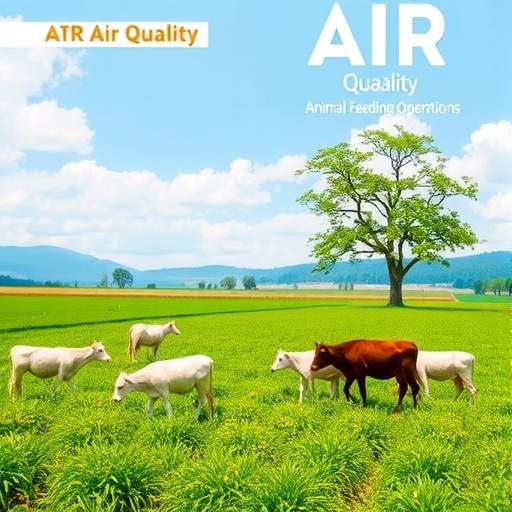In an age where environmental concerns are increasingly at the forefront of public discourse, a new study sheds light on the alarming connection between animal feeding operations (AFOs) and air quality in vulnerable communities across the United States. Conducted by a team of researchers led by S. Chamanara, the study, titled “Geography of animal feeding operations and their contribution to fine particulate matter pollution in vulnerable communities in the United States,” reveals the detrimental impact these operations have on air quality and public health. This research could prove pivotal in informing policy changes and driving necessary shifts in agricultural practices.
The study details the geographical distribution of AFOs and correlates this data with the prevalence of fine particulate matter (PM2.5) pollution—a significant health hazard linked to respiratory issues and cardiovascular diseases. AFOs, which can include livestock farms and large-scale poultry operations, are more than just agricultural entities; they release considerable quantities of particulate matter, ammonia, methane, and other pollutants. Understanding their impact requires a multi-faceted analysis of location, emission sources, and community vulnerability.
In examining the locations of AFOs, the research underscores a troubling pattern: these operations are frequently situated in communities that already suffer from socio-economic disadvantages. This exposure adds another layer to the myriad health risks these populations face. Often, these communities lack the resources to mount effective responses or to demand environmental justice, leading to a vicious cycle of degradation and health inequity. The implications of this geographic mismatch are dire, with the potential for long-term health consequences that could span generations.
The study employs rigorous methodology, combining satellite imagery, environmental monitoring, and demographic data. By analyzing air quality data collected over several years, the researchers were able to clearly establish a link between the proximity of AFOs and heightened levels of PM2.5. The research also highlights seasonal variations in emissions, as operations often ramp up during certain agricultural cycles, exacerbating pollution during vulnerable months.
Furthermore, the investigation delves into the specific health effects associated with exposure to fine particulate matter. These tiny particles, measuring less than 2.5 micrometers, can easily penetrate lungs and enter the bloodstream, leading to severe health issues. The study reports a higher incidence of asthma, other respiratory diseases, and even premature death in communities situated near AFOs. It underscores the urgency of addressing not just the environmental impacts of these operations, but also the public health implications.
Beyond health risks, the study questions the sustainability of AFOs in an era marked by climate change. As climate regulations tighten and the world moves towards greener alternatives, the viability of large-scale feedlots and industrial farming operations becomes increasingly questionable. The authors of the paper advocate for exploring sustainable agricultural practices that not only protect air quality but also ensure food security without causing additional harm to vulnerable communities.
The findings of this study are likely to stir considerable interest among various stakeholders, including policymakers, environmental activists, and community leaders. As public awareness grows regarding environmental justice—defined as the fair treatment of all individuals regardless of race or economic status in environmental governance—this research serves as a clarion call for immediate action. Regulatory bodies may find themselves under pressure to implement stricter regulations on AFOs, particularly in areas identified as hotspots for PM2.5 pollution.
Proposing actionable solutions, the researchers recommend stricter zoning laws that prevent AFOs from being established near residential neighborhoods, particularly those identified as vulnerable. Education plays a crucial role, too; building awareness within communities about the risks associated with AFOs can empower residents to advocate for healthier living environments. Cohesive efforts from local governments, environmental organizations, and public health advocates are essential.
Ultimately, this study underscores a much larger narrative about the intersection of agriculture, public health, and environmental policy. The need for comprehensive reform in how we approach animal agriculture cannot be overstated. As the world grapples with the pressing challenges posed by climate change and pollution, the issues highlighted in this research could serve as a foundational element for catalyzing change in agricultural practices, environmental regulation, and community health initiatives.
As communities seek to reconcile their agricultural practices with the imperatives of public health, the knowledge gained from this study provides a vital piece of the puzzle. By bridging the gap between empirical research and policy, it paves the way for a more sustainable model that prioritizes both food security and human well-being. As the figures indicate, the time for action is now, lest we continue to compromise the health of those most vulnerable among us.
Subject of Research: Air Quality and Public Health Impact of Animal Feeding Operations in Vulnerable Communities
Article Title: Geography of animal feeding operations and their contribution to fine particulate matter pollution in vulnerable communities in the United States
Article References:
Chamanara, S., Gounaridis, D., Goldstein, B. et al. Geography of animal feeding operations and their contribution to fine particulate matter pollution in vulnerable communities in the United States. Commun Earth Environ 6, 620 (2025). https://doi.org/10.1038/s43247-025-02520-w
Image Credits: AI Generated
DOI:
Keywords: Animal Feeding Operations, Air Quality, Particulate Matter, Public Health, Vulnerable Communities.




